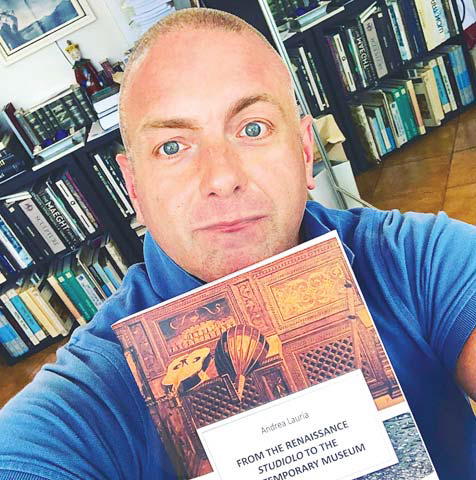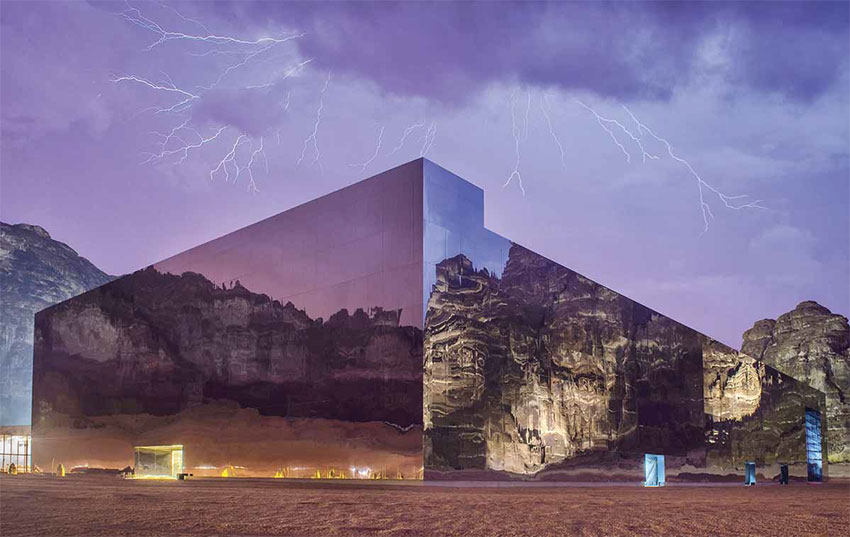11/05/2023
11/05/2023
‘THE MIRROR’ WITH A HEART THAT SPEAKS ITALIAN

Prof. Andrea Lauria is an Italian museologist graduated from Rome’s Accademy of fi ne arts. He also holds a History of Art degree from University di Roma Tre in Rome. Andrea Lauria lectures a Masters course in museology at Rome’s Universities Tor Vergata and American Temple University (Rome Campus). In 2020 he has become a published author of the book: “From the Renaissance studiolo to the contemporary museum” which is also his course manual. Lauria’s fi eld of research is the phenomenon of hyper-museums with special attention to the Arabian countries in comparison with the western world.
In this column up to now I have talked only about Arab Hyper-museums in many arab countries like the UAE, Kuwait, Qatar and also in Egypt. Today I will not describe an Arab hyper-museum but I will tell you about a building that is not a museum but which is certainly an extraordinary architectural work and an incredible landmark. Today we analyze the Maraya Concert Hall in Saudi Arabia. Part of the refl ected landscape, the spectacular multi-purpose structure Maraya Concert Hall is located in Al Ula, in the north-west of Saudi Arabia, a crossroads of ancient civilizations, with its 20,000 years of history, and aims to become a cultural center for events, concerts and both regional and global shows.
As an Italian art historian who studies Arab countries I am particularly interested to write about the Maraya Concert Hall. Maraya, which means mirror in Arabic, has a heart that speaks Italian and I am so proud of it. The structure was in fact designed by Florian Boje of the Giò Forma design studio in Milan, drawing inspiration from the natural landscape in which it is located, just as nature has inspired the architecture and art of numerous civilizations from the times of the Nabataeans up to the our days. The Giò Forma design studio is Milan-based architecture firm founded by Cristiana Picco, Florian Boje and Claudio Santucci has amply demonstrated that it takes its work extremely seriously; they have also designed the Tree of Life for Expo Milan 2015.

The Maraya Concert Hall project management was also led by the Italians Massimo Fogliati and Fabio Pavanetto of Black Engineering. A gigantic cube of mirrors becomes part of the fascinating landscape of AlUla, in Saudi Arabia, a crossroads of ancient civilizations and today a new world reference for events, concerts and meetings. Maraya is a stunning piece of art set in the desert canyon of Ashar Valley. Designed to blend into the surrounding landscape, it rises from the sand like a mirage. Maraya Concert Hall is in fact one of the architectural wonders of the world: 9,740 m2 of mirrors, supplied by Guardian Glass, cover the cubeshaped structure and reflect the vast and enchanting landscapes of AlUla, the first historical site of the Kingdom of Saudi Arabia nominated by the Unesco World Heritage Site. The 26m high theater set a Guinness World Record in 2019 as the world’s largest mirrored building.
Designing and constructing a building in such a particular place it is not easy task, especially if you design an audacious mirror building that is a strong landmark. We are in an area of enormous archaeological and scenic value, the valley called Wadi Al-Qura in the region of Al-’Ula, known as “the Petra of Saudi Arabia” owing to the presence of ruins from the Nabataean empire. It must be said that the choice of mirrors is brilliant for two reasons; the first is that the building itself is not too intrusive in the territory, which in this way is respected, and the second is that the building, reflecting the landscape, becomes a theatre for the surrounding environment, which is the real attraction.
The design of the interiors, including the foyer, the lounge area and the VIP box of the concert hall, is fairly essential. Here the choice has been to utilize local materials (especially stone) as far as possible to evoke a building carved out of the rock by human hand and by the wind. The hall is 26 m in height, which means that stage sets can be moved around just as they are in the world’s leading opera houses. The main auditorium houses 500 seats, along with five boxes with space for up to 60 more guests. The backdrop of the gigantic stage (50×20 m) an 800m2 retractable window can be opened to reveal craggy rock formations, which are illuminated at night and produce colorful reflections. The effect is incredible. Other facilities include a roof terrace, a conference center, exhibition space (including an “infinity room” installation by Yayoi Kusama) and a restaurant. From the terrace-restaurant on the roof visitors can admire the shifting play of light on the surrounding canyon, at any hour of the day and night.
The Maraya Concert Hall is an extraordinary building, built in a splendid natural location, but is located 1000 km from the capital Riyadh and not very easily accessible. I understand that the concert hall was built here to develop the local economy producing businesses for local residents, creating an ideal place to host local and international events. The region wants to be the chosen destination for artists to draw inspiration from a territory that highlights the vestiges of civilizations that have inhabited it over the centuries and emphasizes the importance of architecture and art in the development of the culture of all ages. Such an extraordinary building as The Maraya Concert Hall, to develop its full potential It should be located close to the capital, where other landmark buildings can be designed like an hyper museum designed by a famous Archi star. In this way a cultural district could be developed, as the cultural district on Sa’diyyat Island in the Abu Dhabi, with huge cultural, artistic but also economic potential.
However, it must be said that it is undeniable that the Maraya Concert Hall it is very interesting contemporary architecture. Such a strong landmark created considering the location, respecting the nature of the local segmented rocks and ‘sculpting’ from solid. This Saudi building is unique and leads us to refl ect on the unmistakable geological environment in which it is immersed, on the strong abstraction of the surrounding landscape and on the unusual incursions of man into the natural landscape. The mirrors themselves used as a contemporary canvas, reflect the remarkable heritage of the area. In the same time the mirrors building’s reflections give a sense of enveloping balance: a profound connection of human heritage with nature and the world. What is particularly intriguing to me in The Maraya Concert Hall is that on one side this building, with its mirrors, doesn’t contaminates the beauty of the area but at the same time this construction changes forever the area in which it is built creating a unique metaphysical reality as unique as it is the place where it is located.


